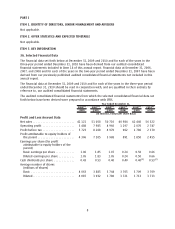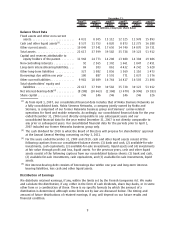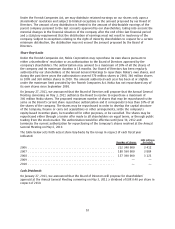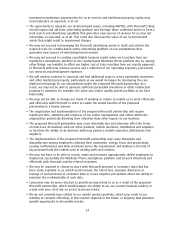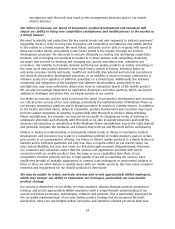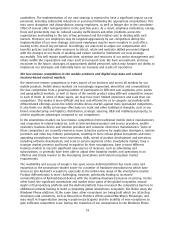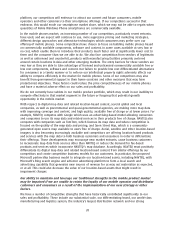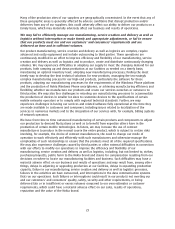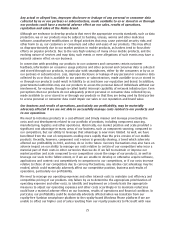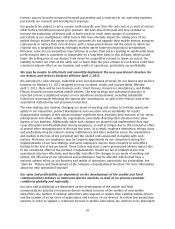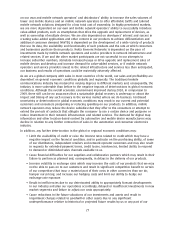Nokia 2010 Annual Report Download - page 19
Download and view the complete annual report
Please find page 19 of the 2010 Nokia annual report below. You can navigate through the pages in the report by either clicking on the pages listed below, or by using the keyword search tool below to find specific information within the annual report.smartphones with Microsoft may result in less management attention paid to our mobile
phones business.
Our failure to increase our speed of innovation, product development and execution will
impair our ability to bring new competitive smartphones and mobile phones to the market in
a timely manner.
We need to identify and understand the key market trends and user segments to address consumers’
expanding needs in order to bring new innovative and competitive smartphones and mobile phones
to the market in a timely manner. We must follow, anticipate and be able to respond with speed to
these key market trends, and actively create future trends in the market, through our product
development processes. We also need to execute efficiently in creating and developing competitive
products, and in bringing our products to market in a timely manner with compelling marketing
messages that succeed in retaining and engaging our current, and attract new, customers and
consumers. Our inability to innovate, develop and bring our mobile products to market and delays in
the ramp up of new product deliveries may result from a variety of factors, including failure to
anticipate consumer trends and needs; insufficient and ineffective internal and external execution in
our research and product development processes; or an inability to secure necessary components or
software assets from suppliers in sufficient quantities on a timely basis. Additionally, the software
complexity and integration of the hardware and software functionalities, particularly in our
smartphones, may cause unforeseen delays even close to anticipated launch of the mobile product.
We are also increasingly dependent on application developers and other partners, which can lead to
additional challenges and delays that are largely outside of our control.
Our ability to innovate and the need to increase the speed of our product development and execution
are critical to the success of our new strategy, particularly the implementation of Windows Phone as
our primary smartphone platform and in bringing products to market in a timely manner. In addition
to the factors described above, delays in innovation, product development and execution may result
from the added complexity of working in partnership with Microsoft to produce Nokia Windows
Phone smartphones. For example, we may not be successful in changing our mode of working to
collaborate effectively and efficiently with Microsoft, or be able to quickly determine and build the
necessary infrastructure to manufacture Nokia Windows Phone smartphones, source the right chipsets
and generally integrate the hardware and software that both we and Microsoft will be contributing.
Failures or delays in understanding or anticipating market trends or delays in innovation, product
development and execution may result in a suboptimal portfolio of mobile products, gaps in certain
price points or an uncompetitive offering. Our failure to deliver mobile products in a timely fashion to
markets and in sufficient quantities not only may have a negative effect on our market share, net
sales and profitability, but may also erode our brand through consumer disappointment. Moreover,
our customers and consumers expect that the services and applications provided with and in
connection with our mobile products have the same or more capabilities than those of our
competitors, function properly and are of high quality. If we fail in launching the services, have
insufficient breadth of available applications or content, have inadequate or unsuccessful updates to
them or there are other defects or quality issues with our mobile products, this may cause consumer
retention and engagement for our mobile products to deteriorate.
We may be unable to retain, motivate, develop and recruit appropriately skilled employees,
which may hamper our ability to implement our strategies, particularly our new mobile
product strategy.
Our success is dependent on our ability to retain, motivate, develop through constant competence
training, and recruit appropriately skilled employees with a comprehensive understanding of our
current and future businesses, technologies, software and products. This is particularly important for
the successful implementation of our new mobile product strategy and the proposed Microsoft
partnership, where we need highlyskilled, innovative and solutionsoriented personnel with new
18


